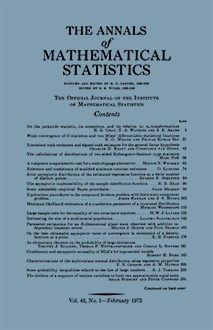Abstract
Let $S_m = X_1 + \cdots + X_m$, where the $X_j$ are independent random variables with common m.g.f. $\phi(t)$ which is assumed to exist in a real interval containing $t = 0$. Let the random variable $n$ be defined as the smallest integer $m$ for which either $S_m \geqq \alpha$ or $S_m \leqq - \beta(\alpha > 0, \beta > 0)$. Thus $n$ can be regarded as the time to absorption for the random walk $S_m$ with absorbing barriers at $\alpha$ and $-\beta$. Let $S = S_n$ and let $F_m(x) = P(-\beta < S_k < \alpha \quad \text{for}\quad k = 1, 2, \cdots m - 1 \quad \text{and} \quad S_m \leqq x)$. The main result of the paper is the identity \begin{equation*}\tag{0.1}E(e^{tS}z^n) = 1 + \lbrack z\phi (t) - 1\rbrack F(z, t),\end{equation*} where $F(z, t) = \sum^\infty_{m = 0} z^m \int^\alpha_{-\beta} e^{tx} dF_m(x).$ Wald's identity follows formally from (0.1) by setting $z = \lbrack\phi(t)\rbrack^{-1}$. Regions of validity of (0.1) and of Wald's identity are discussed, and it is shown that the latter holds for a larger range of values of $t$ than is usually supposed. In Section 5 there are three examples. In the first we consider the case where there is a single absorbing barrier and where the $X_j$ are discrete and bounded. This is a gambler's ruin problem, and we obtain an expression for the probability of ruin. In the second we use the classical random walk to illustrate the region of validity of (0.1). In the third we obtain the Laplace transform of the distribution of the time to absorption in a random walk in which steps of $+1$ and -1 occur at random in continuous time.
Citation
H. D. Miller. "A Generalization of Wald's Identity with Applications to Random Walks." Ann. Math. Statist. 32 (2) 549 - 560, June, 1961. https://doi.org/10.1214/aoms/1177705060
Information





